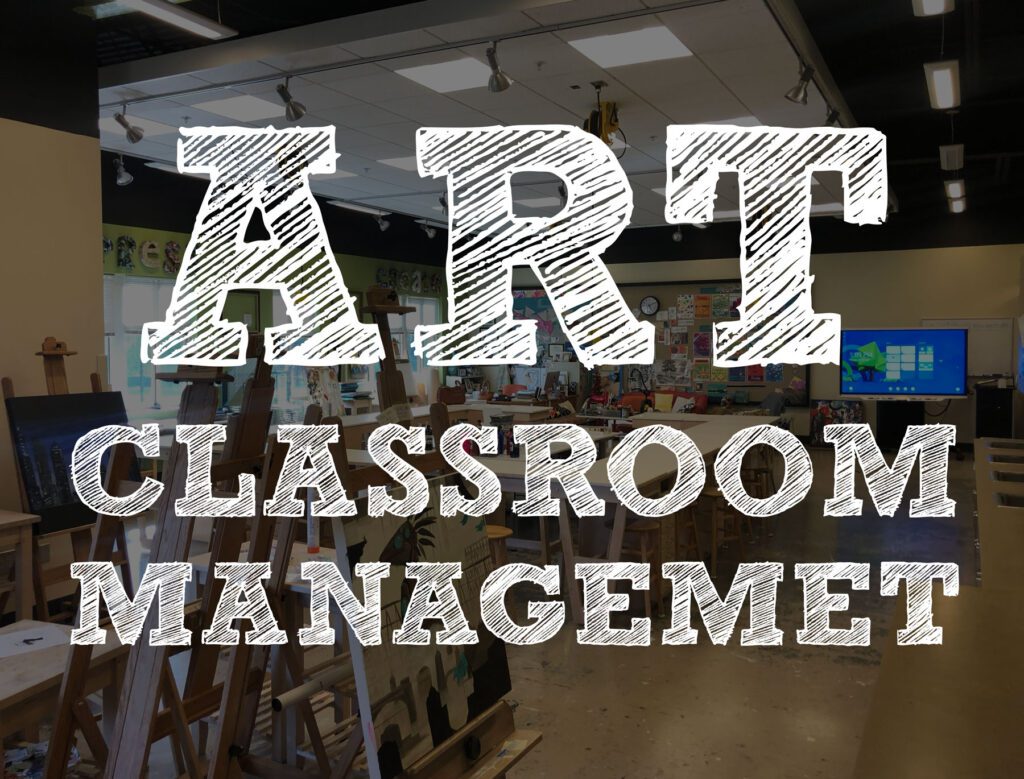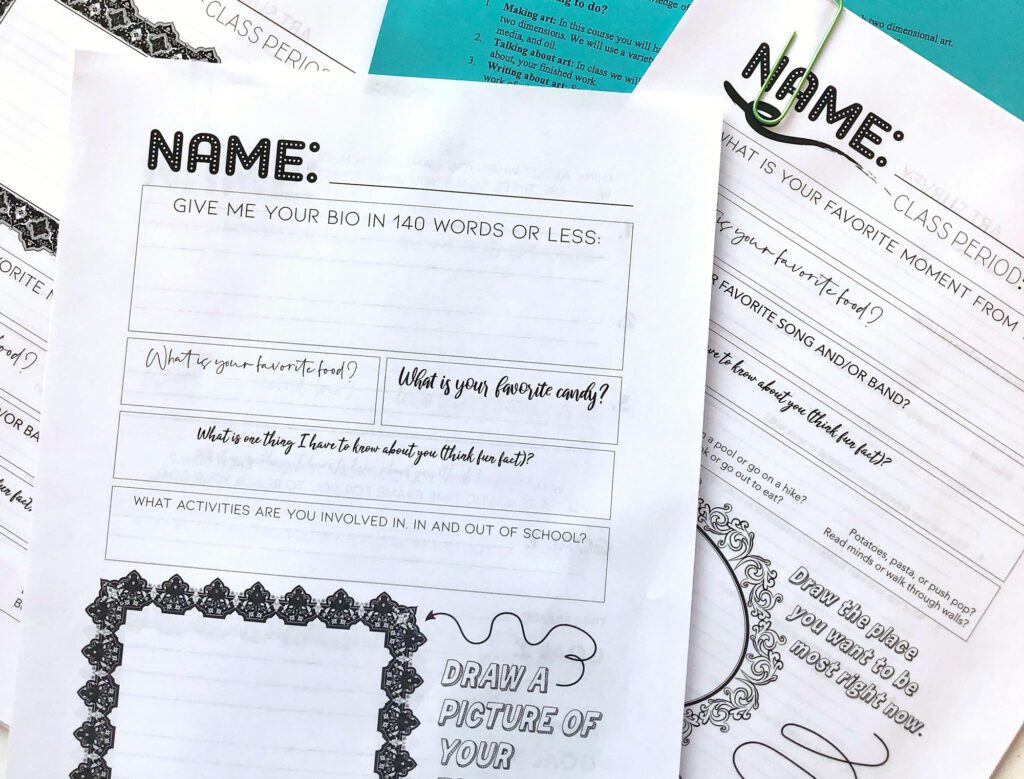Smile at Your Students!

Art classroom management is my least favorite part of the job (grading is a close second) but it’s integral to having a successful, smooth-running classroom. Often, this is the hardest part of teaching, especially if you have a rowdy class. I had just turned 23 when I started teaching, and I taught students who were “super seniors” 19 or 20 years old. Like many teachers, I struggled my first two years to figure out how to manage students, especially those who viewed me as young and easy to manipulate.
While there is no quick trick for art classroom management, the best thing is time and experience, I can share what worked best for me.
Build Relationships

I want to start with relationship building because I truly believe this is the best way to manage students long-term. As a high school teacher, I often taught students more than once. It was always 10x easier to teach students in the second round because they were familiar with me, my rules, and my classroom expectations.
I start building relationships on day one. On the first day of school, I have students fill out a get to know you sheet, which I read later. As they work on this sheet I walk around the room and introduce myself to them individually. I ask them to tell me something about themselves if they are interested in art, and what type of art they like to make. I make small talk while spending intentional time with each student.
I have never liked seating charts, I allow students to select their seats on the first day. As I talk with them individually I fill out a seating chart to reference for attendance and to learn their names. Learn student names! Learn them as quickly as possible, call them by their name, it shows that you know who they are. If students struggle to pay attention or are socializing too much I will move their seats, don’t hesitate to do this it can change the classroom dynamic immediately.
If you build mutual respect with your students I believe your classroom will run more smoothly. I am not a fan of heavy-handed discipline or fear-based relationships with students. If students need a consequence, give it to them, but allow them space to learn and grow from their actions within your class expectations.
Clear Expectations
As I go over the syllabus on the first day of school I also lay out classroom rules. This is the structure of my art classroom management.
- By the time the bell rings, you are in your seat.
- No cleaning up before I say it’s time to clean up.
- Stay in your seat while you wait for the bell to ring.
- If you finish a project, get out something else art-related to work on.
- Clean up after yourself.
- Care for supplies
- No using cell phones in class (although I would allow them to listen to music using headphones towards the middle of the semester, this may vary based on your school’s rules).
- Respect your peers, and don’t comment on their work unless it’s constructive and/or asked for.
- No self-deprecating talk about your art ability. You are here to learn, you aren’t expected to arrive with the knowledge or ability.
My rules are simple and easy to follow. I make sure every student is looking at me and understands the rules as I move through them. I don’t let them push the boundaries on these rules, especially during the first few weeks of school. These rules are the basis of your art classroom management.
Be Firm
If students break rules call them out for it immediately. If you give them an inch they will take a mile. Any wiggle room you allow they will use it and push it. Stay firm, and reinforce rules. Your students are aware of your rules and your expectation is for them to stick to them.
I was the last teacher to hand out detentions at every school I taught. In fact, I often worried I would get called into the principal’s office and questioned why I wasn’t giving uniform violations and cell phone detentions. I was not one to jump immediately to what I viewed as the final punishment. I preferred to remind students of the rules and patiently wait for them to correct their behavior before moving on. If they refused to listen, became disrespectful, or repeatedly broke my rules then the detentions came and the calls home.
I gave out many more detentions at my first school than at my second job, at a private school. The classes were double the size, it was harder to manage so many students in a tight space. But, once I disciplined a student publicly with a detention slip, the rest would fall in line, at least for a period of time.
I try to remind students once, maybe twice about breaking a rule before disciplining. Discipline ranged from detention to speaking to me in the hall to staying after class to going to the administrator’s office. I’ve had to do all of these, and they vary based on the rule they are breaking and their attitude. I tried to hold every student to my expectations, with no exceptions.
The Stare & The Hall

The single most effective way I got students to listen to me was by simply staring at them. If they are talking while I am trying to introduce an assignment, I wait and stare. If a student is being rude, I don’t get combative, I stare at them until they get so uncomfortable they break the gaze. After they have backed down, in the calmest voice possible I correct their behavior or ask to talk to them in the hall.
I’m not joking when I say stare them in the eyes until you can visibly see them wiggle.
One confrontation I had with a student happened after they made a rude comment about me in an effort to get a laugh from his classmates. I walked up to him, stared at him until he broke the gaze, and continued to stare until he muttered an apology. You could hear a pin drop in that room. Rather than addressing it immediately, I asked for him to stay after class. That gave him the rest of the class period to think about what he did and wonder what was coming next. After class I spoke candidly with him about being respectful. He was apologetic, I didn’t give him a detention, and I never had another issue with him again.
That was the base of a relationship built on respect and understanding. Sometimes a one-on-one talk is more effective than anything else.
I prefer to discuss issues with students privately. Calling them to my desk often wasn’t enough, instead, I would ask them to step in the hall. I would give them a few minutes to calm down and consider their actions before stepping out and talking to them.
When a one-on-one talk isn’t working, get parents, guardians, and counselors involved. I wish every student could come around, but some of them don’t. Reach out for support, don’t feel like you have to handle it alone.
Idol Hands

Students get in trouble when they have nothing better to do. It’s possible they will view the current project as not interesting enough to work on, in those cases detentions, low grades, and hall chats will have to come into play. But, before they get to that point, try to keep them busy and out of trouble with early finisher activities, worksheets, and similar.
This is where my weekly visual journal project comes in as my favorite project to teach. Not only does it give you a break from formal teaching every Friday, but when a student finishes an assignment they know to work in their visual journal next. They never have downtime, they always have something to do.
Other options for early finisher work are elements of art and principles of design handouts, Zentangle activities, and even creating a space for them to do a collaborative project such as a class canvas or a table painted white they can doodle on. Consider what you can do to keep them occupied the entire class period.
Smile at Your Students!
Art Classroom Management Summary
Last but not least don’t ever follow the advice not to smile at your students the first weeks or months of school. That was the piece of advice I heard time and time again when talking about art classroom management. Being nice doesn’t equal being a doormat. You can build strong relationships, respect, and offer kindness to your students while still being firm. Art classroom management is about so much more than handing out punishments.
I promise there will be times when you feel out of control in your classroom. Just remember, it’s never too late to come back and assign a week of bookwork if needed (I’ve had to do this). With every moment you feel you didn’t do the right thing you learn something new. Apply that to the next situation. And remember, you are important, valued, and are making an impact in these kids’ lives.
This art classroom management blog post is a part of my art teacher boot camp email series. Interested in learning more information such as how to set up a classroom, what supplies to order, and how to start the year? Sign up for a series of emails over a week here.
Check out 5 projects to keep on hand to plug in if you have a few days of downtime. Also, check out my early finisher activities in my TPT shop.
Don’t forget to follow me on Instagram and TikTok for weekly visual journal demos and other project ideas. Subscribe here to get freebies, project tutorials, and more straight to your inbox. Until next time!

0 Comments